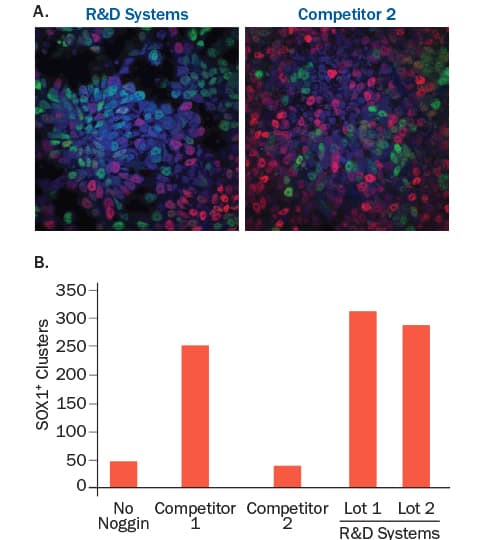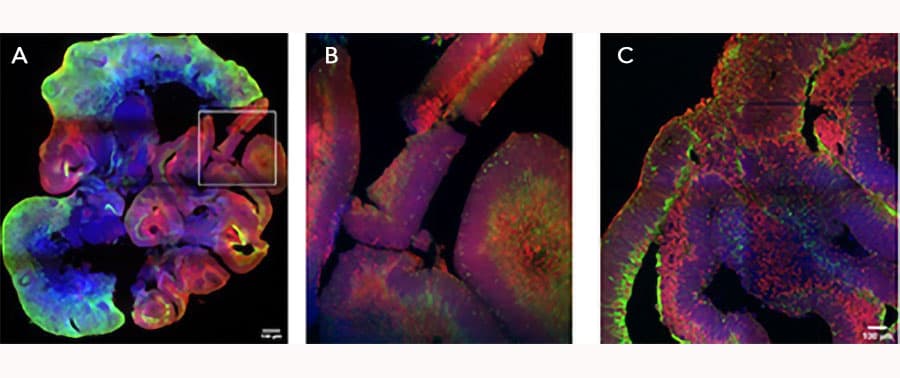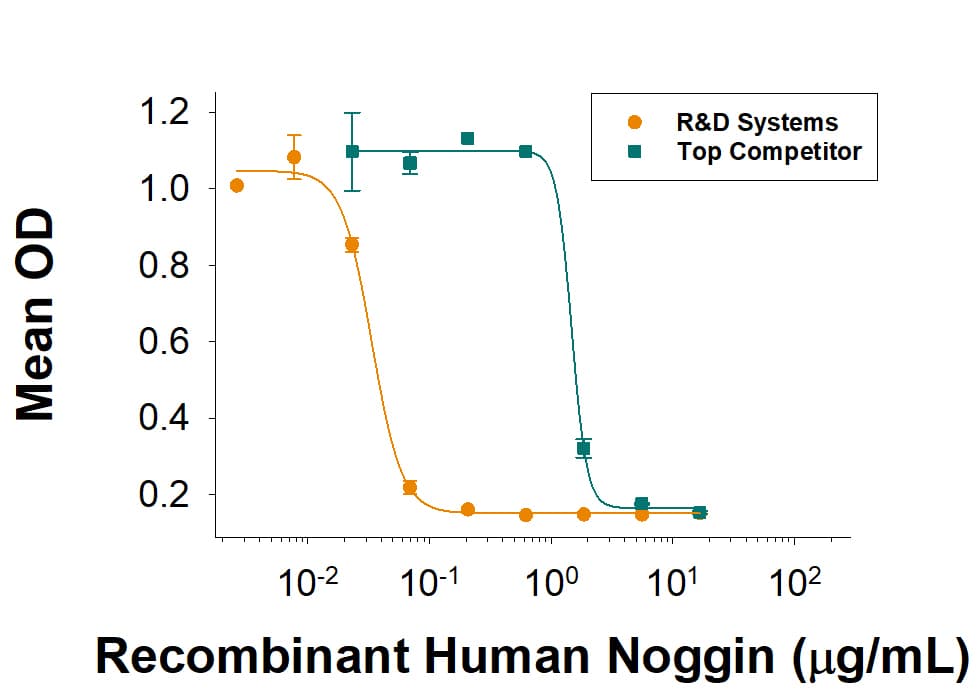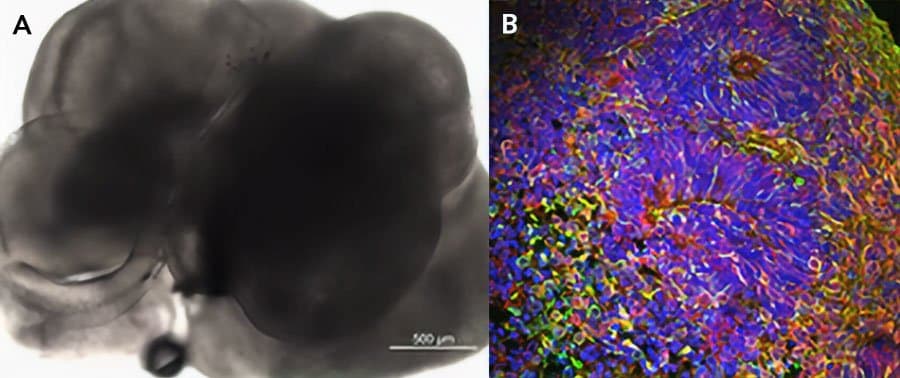 全部商品分类
全部商品分类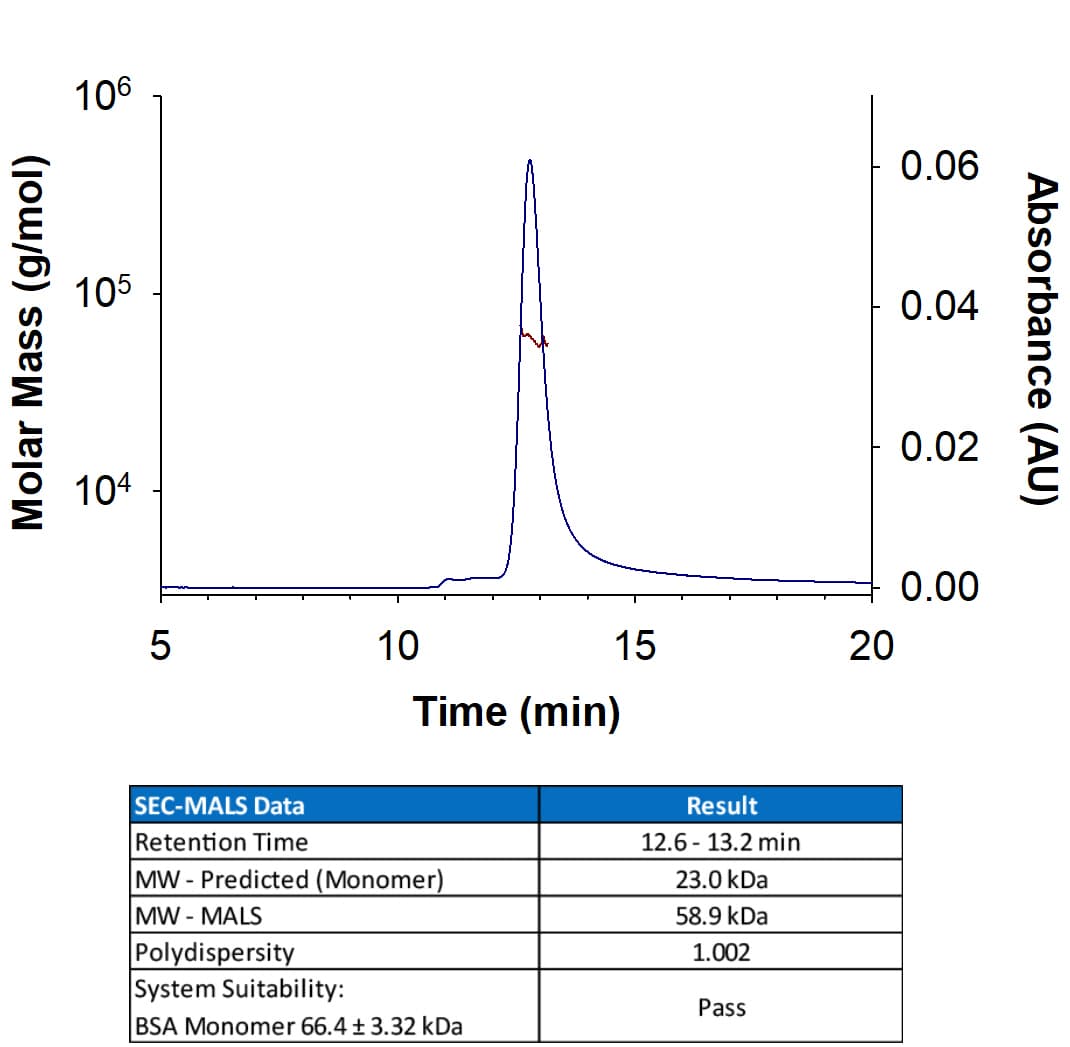



 下载产品说明书
下载产品说明书 下载SDS
下载SDS 用小程序,查商品更便捷
用小程序,查商品更便捷


 收藏
收藏
 对比
对比 咨询
咨询Scientific Data
 View Larger
View LargerRecombinant human Noggin (Catalog # 6057-NG) has a molecular weight (MW) of 58.9 kDa as analyzed by SEC-MALS, suggesting that this protein is a homodimer. MW may differ from predicted MW due to post-translational modifications (PTMs) present (i.e. Glycosylation).
 View Larger
View LargerBG01V human embryonic stem cells were cultured in Mouse Embryonic Fibroblast Conditioned Media supplemented with FGF basic (5 ng/mL). Stem cells were driven into early cells of the neuroectoderm using a 3 day incubation in recombinant human Noggin (25 µg/mL) from either R&D Systems (Lot 1, Lot 2; Catalog # 6057-NG) or from two separate competitors (Competitor 1, Competitor 2). Control cells were not incubated in Noggin (No Noggin). The cells were stained for the early ectoderm marker, Otx2, and the neuroectoderm marker, SOX1. (A) Representative images of SOX1 (green), Otx2 (red), and DAPI (blue) staining in embryonic stem cells differentiated with Noggin from R&D Systems or Noggin from Competitor 2. (B) SOX1+ clusters were quantified under each of the indicated culture conditions. Cells treated with R&D Systems Noggin showed an increase in SOX1+ cells compared to both untreated and competitor-treated cells. R&D Systems Noggin showed consistent differentiation across the lots tested. BG01V human embryonic stem cells are licensed from ViaCyte, Inc.
 View Larger
View LargerRecombinant Human Noggin (Catalog # 6057-NG) inhibits BMP-4 induced alkaline phosphatase production in the ATDC5 mouse chondrogenic cell line. The activity is approximately 30-fold greater than the top competitor's Noggin.
 View Larger
View LargerThe lot-to-lot consistency of Recombinant Human Noggin (Catalog # 6057-NG) was assessed by testing the ability of three independent lots of the protein to inhibit BMP-4-induced alkaline phosphatase production in the ATDC5 mouse chondrogenic cell line (orange, green, red lines). Each trace on the graph represents data obtained from Recombinant Human Noggin from a different manufacturing run. The ED50 for this effect is 0.020-0.160 ug/mL in the presence of 50 ng/mL Recombinant Human BMP-4 (314-BP). The dark blue line on the graph is showing the ability of Recombinant Human BMP-4 (ng/mL) to induce alkaline phosphatase production in the ATDC5 mouse chondrogenic cell line.
 View Larger
View LargeriPSC-derived cerebral organoids (day 45) were cultured using Cultrex UltiMatrix RGF Basement Membrane Extract (BME001-05) and brain organoid culture medium, which includes Recombinant Human FGF-basic (3718-FB) and Recombinant Human Noggin (Catalog # 6057-NG), along with the other reagents listed in the brain organoid culture recipe. Cerebral organoids were stained for Syto6 (blue), Pax6 (red), and Vimentin (green). (A) Image taken at 4x magnification. (B) An enlarged view of the area shown within the white box in part A of the figure. (C) Image taken at 15x magnification. Images courtesy of LifeCanvas Technologies.
 View Larger
View LargeriPSC-derived cerebral organoids (day 45) were cultured using Cultrex UltiMatrix RGF Basement Membrane Extract (BME001-05) and brain organoid culture medium, which includes Recombinant Human FGF-basic (3718-FG) and Recombinant Human Noggin (Catalog # 6057-NG), along with the other reagents listed in the brain organoid culture recipe. (A) Representative brightfield image of day 30 iPSC-derived cerebral organoids. (B) Cerebral organoids stained for beta III-tubulin (green) and Prox1 (red), and counterstained with DAPI (blue).
Carrier Free
CF stands for Carrier Free (CF). We typically add Bovine Serum Albumin (BSA) as a carrier protein to our recombinant proteins. Adding a carrier protein enhances protein stability, increases shelf-life, and allows the recombinant protein to be stored at a more dilute concentration. The carrier free version does not contain BSA.
In general, we advise purchasing the recombinant protein with BSA for use in cell or tissue culture, or as an ELISA standard. In contrast, the carrier free protein is recommended for applications, in which the presence of BSA could interfere.
6057-NG
| Formulation | Lyophilized from a 0.2 μm filtered solution in PBS with BSA as a carrier protein. |
| Reconstitution | Reconstitute at 250 μg/mL in PBS containing at least 0.1% human or bovine serum albumin. |
| Shipping | The product is shipped at ambient temperature. Upon receipt, store it immediately at the temperature recommended below. |
| Stability & Storage: | Use a manual defrost freezer and avoid repeated freeze-thaw cycles.
|
6057-NG/CF
| Formulation | Lyophilized from a 0.2 μm filtered solution in PBS. |
| Reconstitution | Reconstitute at 250 μg/mL in PBS. |
| Shipping | The product is shipped at ambient temperature. Upon receipt, store it immediately at the temperature recommended below. |
| Stability & Storage: | Use a manual defrost freezer and avoid repeated freeze-thaw cycles.
|
Recombinant Human Noggin Protein Summary
Product Specifications
Gln28-Cys232
Analysis

Background: Noggin
Noggin is a secreted homodimeric glycoprotein that is an antagonist of bone morphogenetic proteins (BMPs) (1, 2). Human Noggin cDNA encodes a 232 amino acid (aa) precursor protein; cleavage of a 19 aa signal peptide generates the 213 aa mature protein which contains an N-terminal acidic region, a central basic heparin‑binding segment and a C-terminal cysteine-knot structure (2). Secreted Noggin probably remains close to the cell surface due to its binding of heparin‑containing proteoglycans (3). Noggin is very highly conserved among vertebrates, such that mature human Noggin shares 99%, 99%, 98%, 97% and 89% aa sequence identity with mouse, rat, bovine, equine and chicken Noggin, respectively. Noggin binds some BMPs such as BMP-4 with high affinity and others such as BMP-7 with lower affinity. It antagonizes BMP bioactivities by blocking epitopes on BMPs that are needed for binding to both type I and type II receptors (2, 4). During embryogenesis, Noggin antagonizes specific BMPs at defined times, for example, during neural tube, somite and cardiomyocyte growth and patterning (5-7). During skeletal development, Noggin prevents chondrocyte hyperplasia, thus allowing proper formation of joints (4). Mutations within the cysteine-knot region of human Noggin are linked to multiple types of skeletal dysplasias that result in apical joint fusions (8). Noggin is expressed in defined areas of the adult central nervous system and peripheral tissues such as lung, skeletal muscle and skin (1). During culture of human embryonic stem cells (hESC) or neural stem cells under certain conditions, addition of Noggin to antagonize BMP activity may allow stem cells to proliferate while maintaining their undifferentiated state, or alternatively, to differentiate into dopaminergic neurons (6, 9 - 13). Noggin also appears to maintain adult stem cell populations in-vivo, for example, maintaining neural stem cells within the hippocampus (13).
- Valenzuela, D.M. et al. (1995) J. Neurosci. 15:6077.
- Groppe, J. et al. (2002) Nature 420:636.
- Paine-Saunders, S et al. (2002) J. Biol. Chem. 277:2089.
- Brunet, L. J. et al. (1998) Science 280:1455.
- McMahon, J. A. et al. (1998) Genes Dev. 12:1438.
- Itsykson, P. et al. (2005) Mol. Cell. Neurosci. 30:24.
- Yuasa, S. et al. (2005) Nat. Biotechnol. 23:607.
- Gong, Y. et al. (1999) Nat. Genet. 21:302.
- Xu, R.-H. et al. (2005) Nat. Methods 2:185.
- Wang, G. et al. (2005) Biochem. Biophys. Res. Commun. 330:934.
- Chaturvedi, G. et al. (2009) Cell Prolif. 42:425.
- Chiba, S. et al. (2008) Stem Cells 26:2810.
- Bonaguidi, M.A. et al. (2008) J. Neurosci. 28:9194.


参考图片
BG01V human embryonic stem cells were cultured in Mouse Embryonic Fibroblast Conditioned Media supplemented with FGF basic (5 ng/mL). Stem cells were driven into early cells of the neuroectoderm using a 3 day incubation in recombinant human Noggin (25 µg/mL) from either R&D Systems (Lot 1, Lot 2; Catalog #
6057-NG) or from two separate competitors (Competitor 1, Competitor 2). Control cells were not incubated in Noggin (No Noggin). The cells were stained for the early ectoderm marker, Otx2, and the neuroectoderm marker, SOX1. (A) Representative images of SOX1 (green), Otx2 (red), and DAPI (blue) staining in embryonic stem cells differentiated with Noggin from R&D Systems or Noggin from Competitor 2. (B) SOX1+ clusters were quantified under each of the indicated culture conditions. Cells treated with R&D Systems Noggin showed an increase in SOX1+ cells compared to both untreated and competitor-treated cells. R&D Systems Noggin showed consistent differentiation across the lots tested. BG01V human embryonic stem cells are licensed from ViaCyte, Inc.



